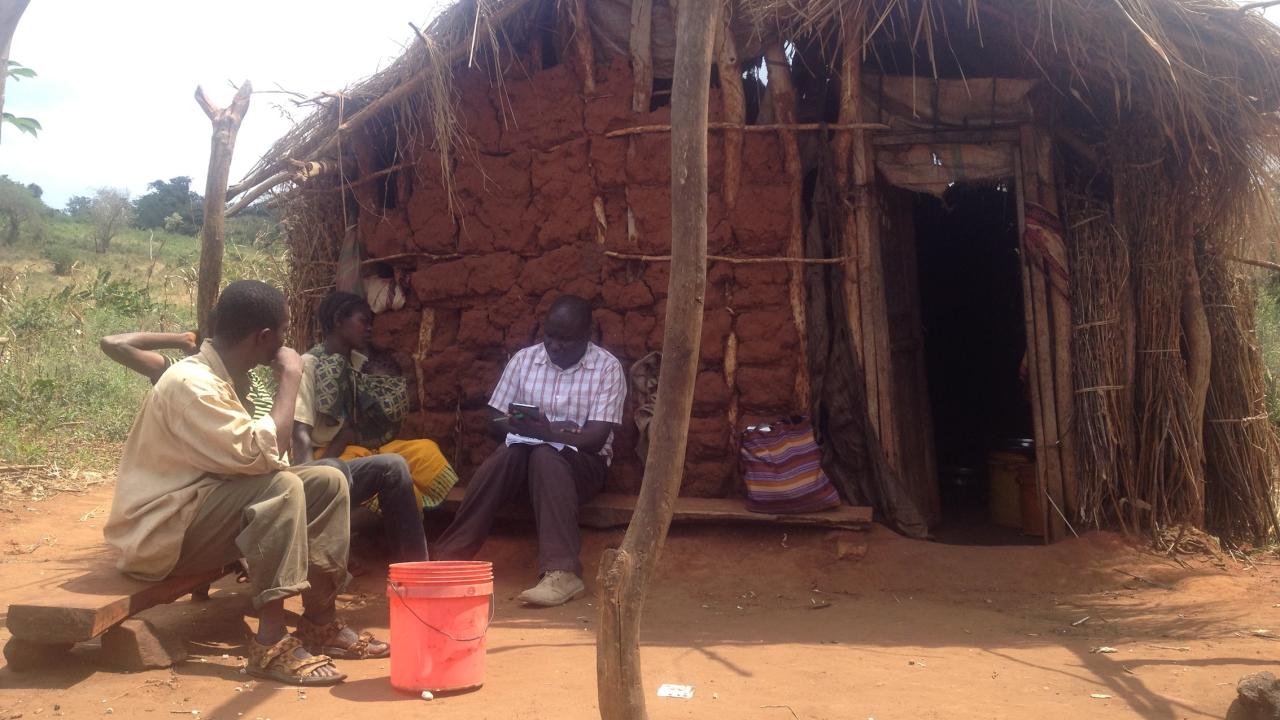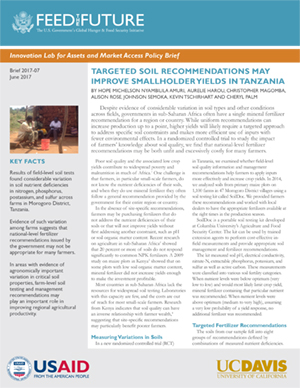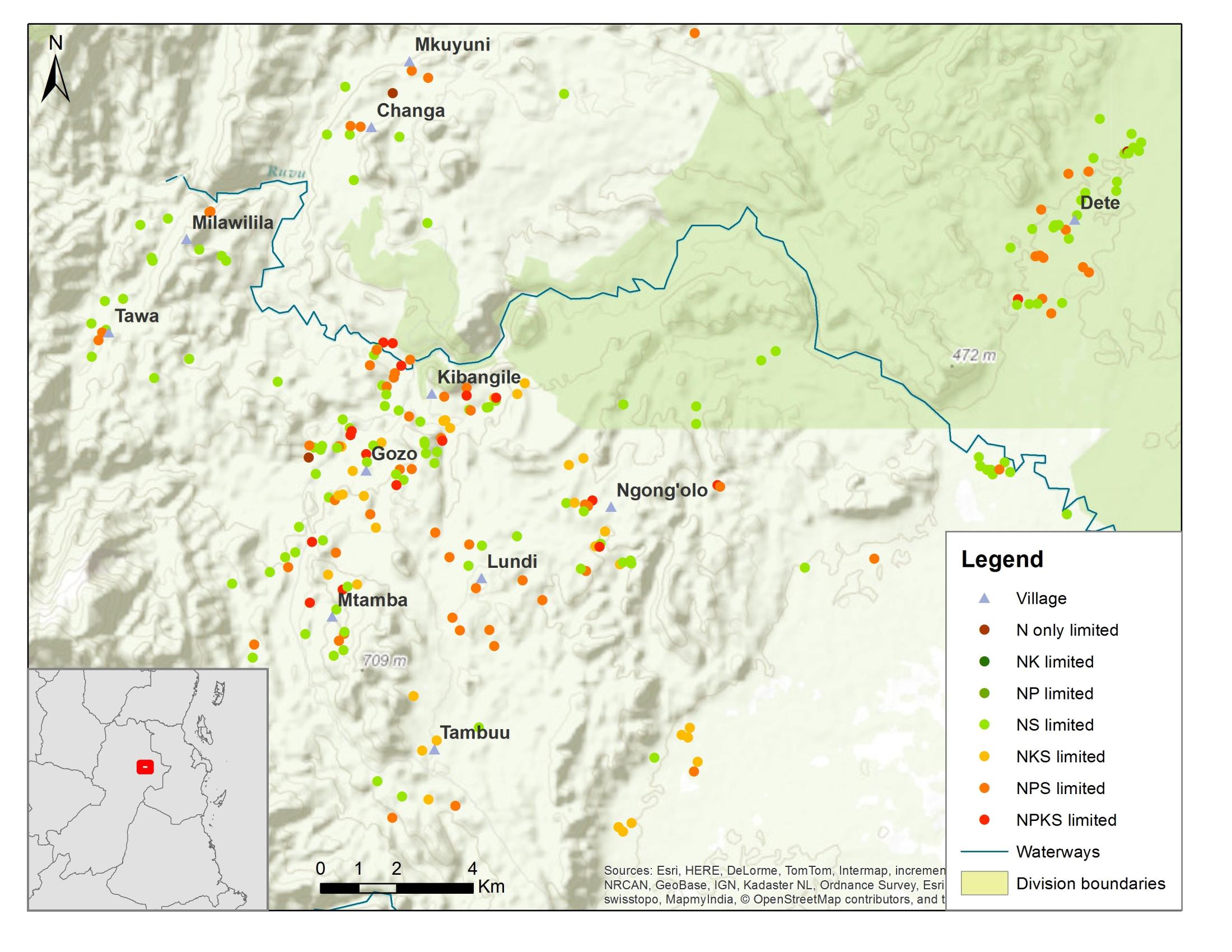
Despite evidence of considerable variation in soil types and other conditions across fields, governments in sub-Saharan Africa often have a single mineral fertilizer recommendation for a region or country. While uniform recommendations can increase production up to a point, higher yields will likely require a targeted approach to address specific soil constraints and makes more efficient use of inputs with fewer environmental effects.
In a randomized controlled trial to study the impact of farmers’ knowledge about soil quality, we find that national-level fertilizer recommendations may be both unfit and excessively costly for many farmers.
Key Facts
- Results of field-level soil tests found considerable variation in soil nutrient deficiencies in nitrogen, phosphorus, postassium, and sulfur across farms in Morogoro District, Tanzania.
- Evidence of such variation among farms suggests that national-level fertilizer recommendations issued by the government may not be appropriate for many farmers.
- In areas with evidence of agronomically important variation in critical soil properties, farm-level soil testing and management recommendations may play an important role in improving regional agricultural productivity.
 Poor soil quality and the associated low crop yields contribute to widespread poverty and malnutrition in much of Africa.[1] One challenge is that farmers, in particular small-scale farmers, do not know the nutrient deficiencies of their soils, and when they do use mineral fertilizer they often follow a general recommendation provided by the government for their entire region or country.
Poor soil quality and the associated low crop yields contribute to widespread poverty and malnutrition in much of Africa.[1] One challenge is that farmers, in particular small-scale farmers, do not know the nutrient deficiencies of their soils, and when they do use mineral fertilizer they often follow a general recommendation provided by the government for their entire region or country.
In the absence of site-specific recommendations, farmers may be purchasing fertilizers that do not address the nutrient deficiencies of their soils or that will not improve yields without first addressing another constraint, such as pH or soil organic matter content. Recent research on agriculture in sub-Saharan Africa[2] showed that 20 percent or more of soils do not respond significantly to common NPK fertilizers. A 2009 study on maize plots in Kenya[3] showed that on some plots with low soil organic matter content, mineral fertilizer did not increase yields enough to make the investment profitable.
Most countries in sub-Saharan Africa lack the resources for widespread soil testing. Laboratories with this capacity are few, and the costs are out of reach for most small-scale farmers. Research from Kenya indicates that soil quality can have an inverse relationship with farmer wealth,[4] suggesting that site-specific recommendations may particularly benefit poorer farmers.
Measuring Variations in Soils
In a new randomized controlled trial (RCT) in Tanzania, we examined whether field-level soil quality information and management recommendations help farmers to apply inputs more effectively and increase crop yields. In 2014, we analyzed soils from primary maize plots on 1,100 farms in 47 Morogoro District villages using a soil testing kit called SoilDoc. We provided farmers these recommendations and worked with local dealers to have the appropriate fertilizers available at the right times in the production season.
SoilDoc is a portable soil testing kit developed at Columbia University’s Agriculture and Food Security Center. The kit can be used by trained extension agents to perform cost-effective infield measurements and provide appropriate soil management and fertilizer recommendations.
The kit measured soil pH, electrical conductivity, nitrate-N, extractable phosphorus, potassium, and sulfur as well as active carbon. These measurements were classified into various soil fertility categories. When nutrient levels were below optimum (very low to low) and would most likely limit crop yield, mineral fertilizer containing that particular nutrient was recommended. When nutrient levels were above optimum (medium to very high), assuming a very low probability of a yield response, no additional fertilizer was recommended.
Targeted Fertilizer Recommendations
The soils from our sample fell into eight groups of recommendations defined by combinations of measured nutrient deficiencies. Phosphorus (P), potassium (K) and sulfur (S) applications were recommended only if soil sample results fell below the critical thresholds. Since nitrogen (N) was limited on almost all plots, its application was recommended for every field. One notable result was the high frequency of sulfur deficiency in the samples, while potassium was available in sufficient quantities in most cases.

We found discrepancies between these field-level recommendations and the current government recommendations. Only five percent of the fields had N and P as the nutrients limiting maize production. Given that the government recommendation for the region includes only Urea and DAP (for N and P nutrients deficiency), most of the sampled fields had additional K or S limitations (or both) and would receive a “lessthan-optimal” mineral fertilizer application with the government recommendation.
In addition, reported use of mineral fertilizer before we conducted soil testing were extremely low. Farmers had applied mineral fertilizer to only 8 out of 1,100 plots the previous season. Farmers often cited lack of funds and the unavailability of mineral fertilizer in nearby markets. Some farmers claimed that the use of mineral fertilizers destroys their soil. Low use rates could also be the outcome of farmers having chosen over time not to use mineral fertilizer because the existing recommendations did not improve yields.
Variations in Fertilizer Costs
Using the wrong input combination is important both agronomically and economically given that the costs differ greatly. The next step is to compare the yields obtained by the government recommendation and the modified recommendation and overall differences in costs. The costs of SoilDoc recommendations showed wide variation depending on the quality of soil on individual plots. Those costs ranged from TSh 57,000 (about US $25) to TSh 145,000 (about US $63) for a half acre.
The government recommendation for the district cost approximately TSh 80,000 (about US $35). Across our samples, the average cost of SoilDoc recommendations was slightly less at TSh 75,600 (about US $33). The majority of farmers had soils that require a combination of N and S, which is priced at TSh 65,000 (about US $29). This suggests that if the average farmer followed the government recommendation, he or she would pay more for fertilizer than necessary.
Improving Profitability for Farmers
These results suggest that site-specific soil testing may improve regional productivity and profitability for smallholder farmers. Though the variation we identified is specific to Tanzania’s Morogoro District, the range of combinations and the proximity of plots with differing soil requirements may be common across the region. A recent study in Kenya found similar variation in soil quality.[5]
Further analysis will determine the benefits of increasing soil testing in the region. For now, projects that support further soil testing and the integration and analysis of evidence could better calibrate sub-regional recommendations and better inform agrodealers about the types of nutrients needed by local farmers.
Hope Michelson is assistant professor of agricultural and consumer economics at the University of Illinois at UrbanaChampaign.
Nyambilila Amuri is lecturer in soil science at Sokoine University of Agriculture.
Aurelie Harou is assistant professor of agricultural and resource economics at McGill University.
Christopher Magomba is lecturer in agricultural economics and agribusiness at Sokoine University of Agriculture.
Cheryl Palm is research professor in the University of Florida Department of Agricultural and Biological Engineering.
Alison Rose is program manager at the International Research Institute for Climate and Society, Earth Institute, Columbia University.
Johnson Semoka is professor of soil science at Sokoine University of Agriculture.
Kevin Tschirhart is agriculture and socioeconomic coordinator at the Agriculture and Food Security Center, Earth Institute, Columbia University.
[1] Barrett et al. 2015. “The self-reinforcing feedback between low soil fertility and chronic poverty.” Nature Geoscience.
[2] Vanlauwe et al. 2010. “Integrated soil fertility management: Operational definition and consequences for implementation and dissemination.” Outlook on Agriculture.
[3] Marenya et al. 2009. “State-conditional fertilizer yield response on western Kenyan farms.” American Journal of Agricultural Economics.
[4] Marenya et al. 2009. “Soil quality and fertilizer use rates among smallholder farmers in western Kenya.” Agricultural Economics.
[5] Tjernström et al. 2015. “The Dirt on Dirt: Soil Characteristics and Variable Fertilizer Returns in Kenyan Maize Systems.” AMA Innovation Lab Working Paper.
This report is made possible by the generous support of the American people through the United States Agency for International Development (USAID). The contents are the responsibility of the Feed the Future Innovation Lab for Assets and Market Access at UC Davis and do not necessarily reflect the views of USAID or the United States Government.
